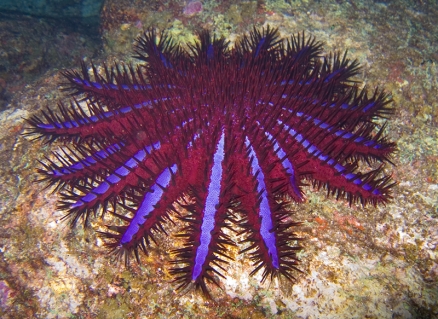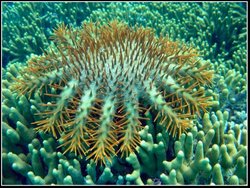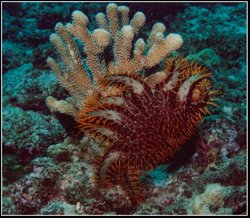Crown-of-thorn sea star

Unusual brightly coloured crown-of-thorns starfish, Thailand Crown of Thorns (Acanthaster planci). Koh Similan, Boulder City, Thailand. (By jon hanson on flickr. (http://www.flickr.com/photos/jonhanson/89930167/) (http://creativecommons.org/licenses/by-sa/2.0), via Wikimedia Commons)
 Crown of thorns starfish. (Photo credit: NOAA)
Crown of thorns starfish. (Photo credit: NOAA)
Acanthaster planci, more commonly known as the crown-of-thorns, is a large sea star found throughout the Indian and Pacific Oceans. Crown-of-thorns live and prey on live corals, often killing them in the process. Through this destructive feeding, crown-of- thorns disrupt the entire reef ecosystem. There are numerous records of sea star outbreaks, which demonstrate the massive amounts of damage they can cause. Although up to this point coral reef ecologists do not know of a good solution to deal with these harmful pests, there are a few indirect methods that can help prevent their outbreaks.
So what exactly is a crown-of-thorn?
Crown-of-thorns are incredibly large sea stars that can reach over half a meter in diameter. Their bodies are covered with sharp spines, approximately 5 cm long, which they use as a defense mechanism against any threat, including humans. Crown-of-thorns have between thirteen and sixteen arms that extend out radially from a central body. They vary in color, with their spines generally having a different color from the rest of their body. Although Acanthaster planci are a species of starfish, they differ from all other starfish in their feeding behavior. Unlike any other starfish, crown-of-thorns prey directly on live coral. But like most sea stars, crown-of-thorns feed by everting (turning inside out) their gastric sac (stomach) through their mouth, covering their food with the sac and digesting it with enzymes. Although their main prey is the soft tissue of scleractinian corals, they eat other types of corals as well. Acanthaster planci typically are most active during the night, however, when their populations become dense they are observed to also feed during daylight hours. Crown-of-thorns can take over [[coral reef]s] quickly due to their ability to spawn millions of eggs a year. Once fertilized, eggs grow to larvae in 24 hours, which then swim across the ocean, dispersing themselves throughout the water column. A month after hatching, the larvae go through metamorphosis to become juvenile sea stars with five arms. They continue growing arms for the next couple of months and two years after birth, the crown-of-thorns are old enough to reproduce. In densely populated areas their growth is limited, causing them to be smaller in size than those in sparse habitats. A few species of fish are known to eat these large sea stars including triton shells, painted-prawns, green triggerfish and the Napoleon wrasse. Predation, however, does not seem to have a large impact on their survival.
 Triton shells are one of the main predators of crown-of-thorns. (Photo credit: NOAA)
Triton shells are one of the main predators of crown-of-thorns. (Photo credit: NOAA) Without many predators, crown-of-thorn populations can grow exponentially, leading to reef destruction and change in reef ecology. Crown-of-thorns have been present on reefs for millions of years, but major outbreaks were not observed until the 1960s. Outbreaks sometimes occur in areas with high levels of nutrients, which generally accumulate from terrestrial runoff. During outbreaks, crown-of-thorns not only eat live, adult coral, but also prevent the recruitment of juvenile corals. This prevents coral population growth, hindering a coral colony’s ability to recover from predation. Each sea star can eat up to a meter-squared of coral each month, so when their populations become large they can quickly kill entire coral colonies. Once the sea stars deplete one area of live coral, they move on to adjacent regions. The only thing that limits their movement is soft, sandy areas, which they have trouble moving across. Outbreaks of crown-of-thorns typically last between 1-5 years, although on large complex reef systems an outbreak can last 15-20 years. This is due to the fact that many reefs are in close proximity, which allows the crown-of-thorns to spread from reef to reef. After an outbreak, the reefs begin to recover, but it may take one or many decades for them to reach original levels of coral cover. In one study area along the coast of Guam during an outbreak, the sea star was shown to reduce coral populations by 90% from the low tide level to the limit of coral growth. After this massive loss of living coral, the area was quickly overgrown with algae and most of the fish living in the area disappeared.
 Destruction caused by the crown of thorn sea star. (Photo credit: NOAA)
Destruction caused by the crown of thorn sea star. (Photo credit: NOAA) Although most studies agree that sea stars are incredibly harmful to the reefs that they prey on, one study by James Porter, reported that the Acathaster are actually somewhat beneficial to the reefs by preventing one species of corals from monopolizing the area. Porter, suggested that crown-of-thorns were actually increasing the diversity of coral species. In his study he showed that reefs with 1Acathasterper 50m2 had much more coral biodiversity than reefs that had 1per 50,000m2. All locations had the same number of species, but the species were more evenly distributed when there were higher populations of sea stars. Although crown-of-thorns may benefit species richness in some areas, numerous studies have proven that they are detrimental across several different reefs.
The massive loss of corals by crown-of-thorns is taking a big toll on the tourist economy. After a large crown-of-thorn outbreak, the reefs are destroyed and most of the fish have left the area. This is unfavorable to tourists who pay to come to see the beauty and color of live, healthy reefs. Many coastal towns around the world depend heavily on the tourism in order to for their residents to make a living. But what can be done to stop these outbreaks? Crown-of-thorn outbreaks have been correlated with high nutrient levels, which accumulate from terrestrial runoff. Thus, reducing the amount of terrestrial runoff would help prevent large populations from developing. Runoff is a large-scale problem, however, and is very difficult to mitigate. Another cause of outbreaks is the overfishing of some of the crown-of-thorns main predators. Without the fish populations to keep the levels of crown-of-thorns in balance, the sea stars explode in numbers. This means that regulating the fishing practices around the world would be useful in preventing the crown-of-thorns from destroying reefs. Some people have taken the matter into their own hands and taken groups of divers out to the reefs in order to kill the crown-of-thorns themselves. Originally this was done by stabbing and cutting up the sea stars, but it was discovered that the pieces were able to regenerate and create an even larger problem. The next method used was to remove the sea stars from the reefs and bury them on shore. This could be an efficient method in local areas, but crown-of-thorns are dangerous to handle and much care must be given to the method of removal. Divers have also attempted to kill the crown-of-thorns by injecting them with poison. This method is very efficient and has been attempted on a very large scale. One problem with the injection method, however, is that many of the poisons, such as copper sulfate, leave pollutants (heavy metals) in the water. Other poisons have also been tried, but they are not as effective as copper sulfate, tend to damage the injection guns and are harmful to the people handling them. Sodium bisulphate is currently the best choice to poison crown-of-thorns with, since it eventually breaks down in seawater. The full consequences of releasing this chemical into the oceans has yet to be fully analyzed. So far, no one has come up with a good large-scale solution to deal with these destructive invertebrates.
Further Reading
- Branham, J. M. 1973. The Crown of Thorns on Coral Reefs. BioScience 23: 219-226.
- Chesher, R.H. 1969. Destruction of Pacific Coral Reefs by the Sea Star Acanthaster planci. Science 165: 280-283.
- “Crown of Thorns Starfish.” 1997. Australian Institute of Marine Science. Australian Government. 19 Nov. 2004.
- “Indicators of Reef Health.” Indonesia Oceanic Cetacean Program. Apex Environmental. 19 Nov. 2004.
- Porter, J.W. 1972. Predation by Acanthaster and Its Effect on Coral Species Diversity. The American Naturalist 106: 487-492.
1 Comment
patatas nikos wrote: 10-01-2011 04:39:01
Hi, I have a school presentation for this animal and I was wondering if you happen to know about its average life span..I can't really find anything except this http://www.strangeanimals.info/2011/10/crown-of-thorns-starfish.html that just says they can live for more than 8 years :/